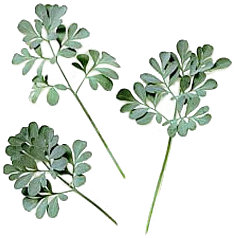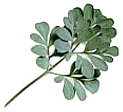

Rue

Ruta. (from Greek ryte, rue.) RUE. Rutaceae. Eight species of pungently aromatic more or less woody perennial herbs. Leaves alternate, rarely opposite, usually 2-pinnatisect or 3-pinnatisect, gland-dotted. Inflorescence cymose, bracteate; sepals and petals 4, frequently 5 in the central flower, petals more or less culcullate, yellow, dentate or ciliate or more rarely entire; stamens twice number of petals (8 or 10); ovary superior. Capsule 4-lobed or 5-lobed, dehiscent. Macronesia, E Europe, SW Asia. CultivationRuta graveolens has long been cultivated for its strong flavour, used particularly in sausage; rue tea, made from an infusion of the leaves, has been used as a stimulant. It is valued throughout the European-influenced world as a bitter herb, often held to have magical properties - particularly if obtained by theft. The other species are occasionally cultivated for their decorative glaucous, deeply divided leaves and curious yellow flowers. The few species from the Canary Islands are rarely found in botanic gardens, in particular Ruta oreojasme. Ruta graveolens is easily grown on any soil but prefers well-drained or rocky soils. It will thrive in fairly dry positions in partial shade but will survive successfully in full sun. It may be pruned back to encourage fresh growth after damage inflicted by severe winters. Propagate from semi-ripe cuttings taken in late summer placed in an outdoor frame in a sandy compost or grow from seed sown as soon as ripe. Old plants will layer branches which trail and root on the soil surface. The sap contains furanocoumarins which sensitise the skin to light and may cause blistering and dermatitis. Ruta graveolensRUE; HERB OF GRACE. Glabrous, glaucous blue shrub 20-50cm. Lower leaves more or less long petiolate, segments usually bipinnatisect, ultimate segments 2-9mm wide, lanceolate, narrowly oblong to obovate. Inflorescence lax, pedicels equal to or exceeding the capsules, bracts lanceolate, leaf-like; sepals lanceolate, acute; petals yellow oblong-ovate, denticulate, margins undulate. Balkan Peninsula, SE Europe. ‘Blue Curl’: dwarf bushy; leaves lacy, blue. ‘Blue Mound’: mound-forming; leaves tinted blue. ‘Curly Girl’: dwarf, compact; leaves lacy, blue. ‘Jackman’s Blue’: leaves distinctly glaucous. ‘Variegata’: leaves edged with creamy white. Z5.
|
Home
Grow Nuts
Grow Fruit
Grow Vegetables
Cyberian Index
If you like this website and want one of your own contact
Cyberian All information correct at
time of publication and open to updates as necessary. No part of this website,
or its vectors, may be produced in any shape or form, using any type or design
of medium, system, equipment or otherwise without the prior written consensual
notice of the Cyberian. Any breach of these requirements will result in the
appropriate action. If in doubt, e-mail contact is recommended.
Some components of this website were obtained as open-source software and are
used in the same non-profit manner on this website.